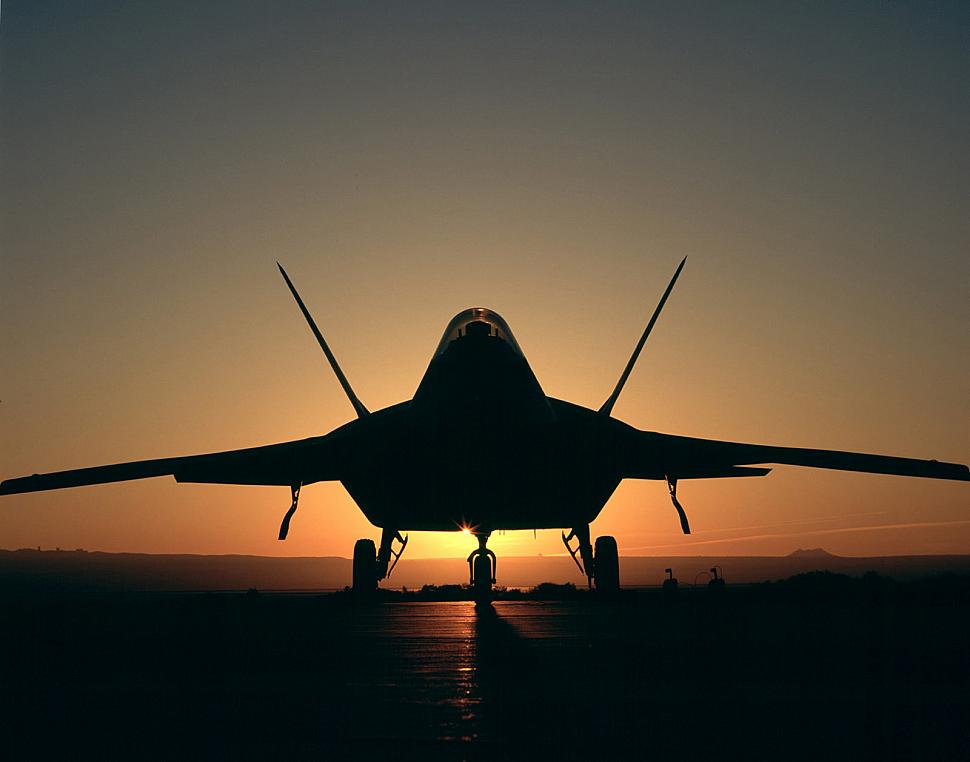Fighter Jet News
F-22 Raptor News
F-22 industry team concludes ground-based, full-scale static testing
May 15, 2002 (by
Jeff Hollenbeck) -
The F-22 industry team has successfully completed all planned static testing of the F-22, demonstrating that the structural integrity of the airframe can withstand forces 50 percent higher than those expected in service life.

This milestone completes almost three years of full-scale static testing on Raptor 3999 - one of two non-flying F-22 airframes located at Lockheed Martin Aeronautics' facility in Marietta, Ga.
"The unprecedented success of this static testing is testament to the sophisticated tools and talents of the dedicated engineers who designed the F-22," said Bob Rearden, Lockheed Martin Aeronautics Co. vice president and F-22 program general manager. "Successfully completing these tests gives the Air Force great confidence that the F-22 will meet or exceed all expectations for structural integrity."
Since 1999, Raptor 3999's airframe has been subjected to loads applied by numerous hydraulic rams designed to simulate forces the aircraft actually encounters during flight. This testing is done primarily to demonstrate the structural integrity of the airframe.
During any given test, as many as 3,600 individual sensors relay aircraft structural information every 250 milliseconds to the engineers who are monitoring the tests in real-time at F-22 facilities in Seattle, Wash., Fort Worth, Texas, and Marietta, Ga. The forces applied are 50 percent higher than are ever expected in service. This provides the government-mandated safety factor.
Unlike many fighters designed in the past, the F-22 fly-by-wire flight control system is optimized for maximum performance for all points in the sky. This required many more test cases to be run to ensure all corners of the flight envelope were tested.

The application of advanced avionics software in the F/A-22 is key to the Raptor's revolutionary performance advantage over any other fighter. In the air-to-air arena, the stealthy F/A-22 will be virtually unseen on radar, while its sophisticated array of sensors and advanced radar will allow it to reach out and strike adversary aircraft undetected from long range. The advanced software package will also enhance the Raptor's ability to deliver precision air-to-surface weapons on target, day or night, in any weather. [U.S. Air Force photo by Kevin Robertson]
"The unprecedented success of this static testing is testament to the sophisticated tools and talents of the dedicated engineers who designed the F-22," said Bob Rearden, Lockheed Martin Aeronautics Co. vice president and F-22 program general manager. "Successfully completing these tests gives the Air Force great confidence that the F-22 will meet or exceed all expectations for structural integrity."
Since 1999, Raptor 3999's airframe has been subjected to loads applied by numerous hydraulic rams designed to simulate forces the aircraft actually encounters during flight. This testing is done primarily to demonstrate the structural integrity of the airframe.
During any given test, as many as 3,600 individual sensors relay aircraft structural information every 250 milliseconds to the engineers who are monitoring the tests in real-time at F-22 facilities in Seattle, Wash., Fort Worth, Texas, and Marietta, Ga. The forces applied are 50 percent higher than are ever expected in service. This provides the government-mandated safety factor.
Unlike many fighters designed in the past, the F-22 fly-by-wire flight control system is optimized for maximum performance for all points in the sky. This required many more test cases to be run to ensure all corners of the flight envelope were tested.
Related articles:
Forum discussion:
Tags
- Newest advanced integrated avionics software flown for first time aboard the F-22 Raptor ( 2002-05-07)
- F-22 Raptor industry team donates 1/10th-scale aircraft model to U.S. Air Force Academy ( 2002-04-19)
- F-22 industry team delivers Raptor 4009 to USAF Logistics Test & Evaluation Team ( 2002-04-15)
- F-22 Raptor news archive
Forum discussion:
- Start a discussion about this article in the F-22 forum.
Tags
